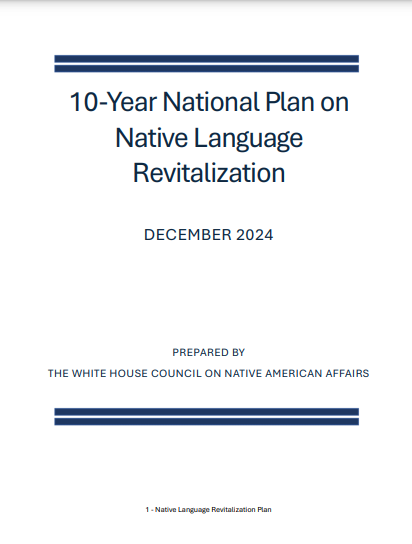WASHINGTON — The White House Council on Native American Affairs is leaving behind a blueprint for the revitalization of tribal languages for Congress and the next administration.

The spiral-bound document titled “10-Year National Plan on Native Language Revitalization” was shared with participants at the 2024 White House Tribal Nations Summit, which took place in Washington on December 9.
The 47-page document details the actions necessary for the government to address their role in the loss of Native languages across various tribes across the United States.
The Plan states that if action is not taken, some estimate that by 2050 fewer than 20 Native languages may still be in use; a sharp decrease from the estimated 167 currently spoken. The Plan calls for an annual investment of at least $2.5 million to support their three pronged approach.
“The legacy of forced assimilation continues to threaten the existence of many Native languages, and the legacy of the boarding school era echoes in today’s educational experience for Native students. Congressional action is required now to preserve Native languages,” the report summarizes.
The approach stems from three implementation strategies: expand access to immersion language environments, support community-led revitalization efforts, and develop, grow, and sustain Native language support networks. These efforts would require an investment of $16.7 billion between 2025 and 2035, or $1.5 billion per year. This is in comparison to the current investment of only $41.5 million in FY2024 which is split between three agencies: Health and Human Services, DOI, and the Department of Education.
“Between 1871 and 1969, the U.S. government allocated at least $23.3 billion (adjusted for inflation) to the federal Indian boarding school system and related assimilation policies. This $16.7 billion proposal reflects the United States’ current policy to preserve, protect, and promote the inherent rights of Native Americans to use, practice, and develop their own languages.”
Immersion language programs are one of the best ways to secure the future of Native languages. This Plan wants to support 100 “language nests” that are educational programs for children under the age of seven, fund 100 new K-12 Native language immersion schools where at least 50% of instruction is completed in a Native language, provide scholarships for families to access language resources, and support the creation of 37 centers dedicated to language studies.
On top of supporting immersion programs, this plan wants to support 100 mentor-apprentice programs where fluent speakers are paired with adult learners to ensure the language gets passed down generation-to-generation, as well as fund community-based summer, supplemental, and afterschool programs to increase access to language outside of school. This plan also wants to recruit and train 10,000 Native language teachers.
Like everything else, heavy programming requires funding. This plan wants to establish funds accessible to community organizations, tribes, and individuals, provide technical assistance for schools and programs, as well as restructure the way federal funds are allocated ensuring that funding flows directly to Native Nations.
“Inaction is no longer acceptable. Many Native American languages are endangered as a direct result of past federal policies. Today, the U.S. government is called upon to work urgently and boldly to invest in and support Native communities in revitalizing their respective languages so that they are once again vibrantly spoken, heard, practiced, and normalized in everyday use,” stated in the Plan.
The White Hosue Council on Native American Affairs Committee on Education wrote the plan with the Office of the Assistant Secretary-Indian Affairs, Department of the Interior, the White House Inititative on Advancing Educational Equity, Excellence and Economic Opportunity for Native Americans and Strengthening Tribal Colleges and Universities, Department of Education, Administration for Native Americans, Department of the Health & Humans Services, adn the White House Domestic Policy Council.
Create your own user feedback survey
More Stories Like This
50 Years of Self-Determination: How a Landmark Act Empowered Tribal Sovereignty and Transformed Federal-Tribal RelationsNavajo Nation President Nygren Files in Court to Halt Removal Legislation
Alcatraz Sunrise Gathering Marks 50 Years of Indigenous Activism
Navajo Nation Vice President Distances Herself From President After Removal Resolution
Navajo Council Speaker Introduces Legislation to Remove Navajo Nation President, Vice President Amid Ethics Complaint
Help us tell the stories that could save Native languages and food traditions
At a critical moment for Indian Country, Native News Online is embarking on our most ambitious reporting project yet: "Cultivating Culture," a three-year investigation into two forces shaping Native community survival—food sovereignty and language revitalization.
The devastating impact of COVID-19 accelerated the loss of Native elders and with them, irreplaceable cultural knowledge. Yet across tribal communities, innovative leaders are fighting back, reclaiming traditional food systems and breathing new life into Native languages. These aren't just cultural preservation efforts—they're powerful pathways to community health, healing, and resilience.
Our dedicated reporting team will spend three years documenting these stories through on-the-ground reporting in 18 tribal communities, producing over 200 in-depth stories, 18 podcast episodes, and multimedia content that amplifies Indigenous voices. We'll show policymakers, funders, and allies how cultural restoration directly impacts physical and mental wellness while celebrating successful models of sovereignty and self-determination.
This isn't corporate media parachuting into Indian Country for a quick story. This is sustained, relationship-based journalism by Native reporters who understand these communities. It's "Warrior Journalism"—fearless reporting that serves the 5.5 million readers who depend on us for news that mainstream media often ignores.
We need your help right now. While we've secured partial funding, we're still $450,000 short of our three-year budget. Our immediate goal is $25,000 this month to keep this critical work moving forward—funding reporter salaries, travel to remote communities, photography, and the deep reporting these stories deserve.
Every dollar directly supports Indigenous journalists telling Indigenous stories. Whether it's $5 or $50, your contribution ensures these vital narratives of resilience, innovation, and hope don't disappear into silence.
 The stakes couldn't be higher. Native languages are being lost at an alarming rate. Food insecurity plagues many tribal communities. But solutions are emerging, and these stories need to be told.
The stakes couldn't be higher. Native languages are being lost at an alarming rate. Food insecurity plagues many tribal communities. But solutions are emerging, and these stories need to be told.
Support independent Native journalism. Fund the stories that matter.
Levi Rickert (Potawatomi), Editor & Publisher

